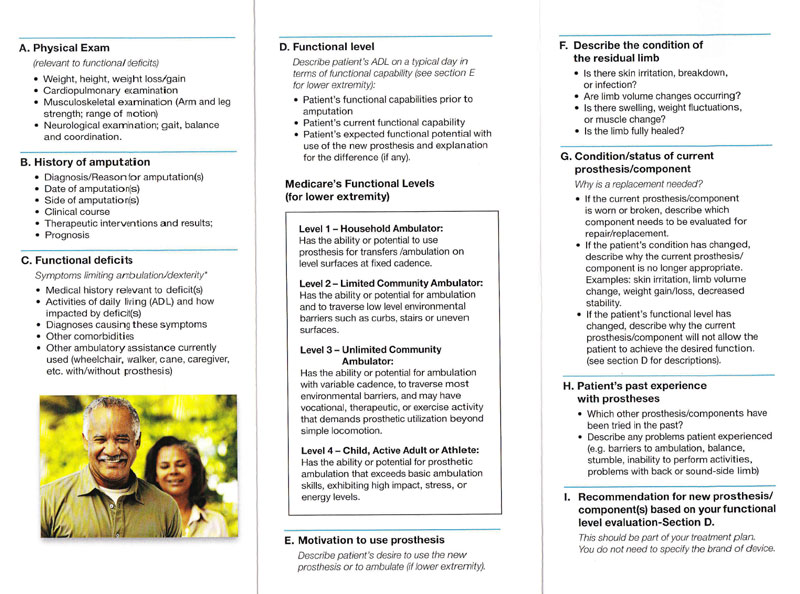When Referring Your Patient to a Prosthetist
A. Physical Exam
(relevant to functional deficits)
• Weight, height, weight loss/gain
• Cardiopulmonary ex.amination
• Musculoskeletal examination (Arm and leg strength; range of motion)
• Neurological examination; gait, balance and coordination.
B. History of amputation
• Diagnosis/Reason for amputation(s)
• Date of amputation(s)
• Side of amputation(s)
• Clinical course
• Therapeutic interventions and results;
• Prognosis
C. Functional deficits
Symptoms limiting arnbulation/dexterity*
• Medical history relevant to deficit(s)
• Activities of daily living (ADL) and how impacted by deficit(s)
• Diagnoses causing these symptoms
• Other comorbidities
• Other ambulatory assistance currently used (wheelchair, walker, cane, caregiver, etc. with/without prosthesis)
D. Functional level
Describe patient’s ADL on a typical day in terms of functional capability (see section E for lower extremity):
• Patient’s functional capabilities prior to amputation
• Patient’s current functional capability
• Patient’s expected functional potential with use of the new prosthesis and explanation for the difference (if any).
Medicare’s Functional Levels (for lower extremity)
Level 1 – Household Ambulator:
Has the ability or potential to use prosthesis for transfers /ambulation on level surfaces at fixed cadence.
Level 2 – Limited Community Ambulator:
Has the ability or potential for ambulation and to traverse low level environmental barriers such as curbs, stairs or uneven surfaces.
Level 3 – Unlimited Community Ambulator:
Has the ability or potential for ambulation with variable cadence, to traverse most environmental barriers, and may have vocational, therapeutic, or exercise activity that demands prosthetic utilization beyond simple locomotion.
Level 4 – Child, Active Adult or Athlete:
Has the ability or potential for prosthetic ambulation that exceeds basic ambulation skills, exhibiting high impact, stress, or energy levels.
E. Motivation to use prosthesis
Describe patient’s desire to use the new prosthesis or to ambulate (if lower extremity).
F. Describe the condition of the residual limb
• Is there skin irritation, breakdown, or infection?
• Are limb volume changes occurring?
• Is there swelling, weight fluctuations, or muscle change?
• Is the limb fully healed?
G. Condition/status of current prosthesis/component
Why is a replacement needed?
• If the current prosthesis/component is worn or broken, describe which component needs to be evaluated for repair/replacement.
• If the patient’s condition has changed, describe why the current prosthesis/ component is no longer appropriate.
Examples: skin irritation, limb volume change, weight gain/loss, decreased stability.
• If the patient’s functional level has changed, describe why the current prosthesis/component will not allow the patient to achieve the desired function. (see section D for descriptions).
H. Patient’s past experience with prostheses
• Which other prosthesis/components have been tried in the past?
• Describe any problems patient experienced (e.g. barriers to ambulation, balance, stumble, inability to perform activities, problems with back or sound-side limb).
I. Recommendation for new prosthesis/ component(s) based on your functional level evaluation-Section D.
This should be part of your treatment plan.
You do not need to specify the brand of device.

